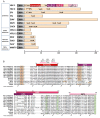The frantic play of the concealed HIV envelope cytoplasmic tail
- PMID: 23705972
- PMCID: PMC3686653
- DOI: 10.1186/1742-4690-10-54
The frantic play of the concealed HIV envelope cytoplasmic tail
Abstract
Lentiviruses have unusually long envelope (Env) cytoplasmic tails, longer than those of other retroviruses. Whereas the Env ectodomain has received much attention, the gp41 cytoplasmic tail (gp41-CT) is one of the least studied parts of the virus. It displays relatively high conservation compared to the rest of Env. It has been long established that the gp41-CT interacts with the Gag precursor protein to ensure Env incorporation into the virion. The gp41-CT contains distinct motifs and domains that mediate both intensive Env intracellular trafficking and interactions with numerous cellular and viral proteins, optimizing viral infectivity. Although they are not fully understood, a multiplicity of interactions between the gp41-CT and cellular factors have been described over the last decade; these interactions illustrate how Env expression and incorporation into virions is a finely tuned process that has evolved to best exploit the host system with minimized genetic information. This review addresses the structure and topology of the gp41-CT of lentiviruses (mainly HIV and SIV), their domains and believed functions. It also considers the cellular and viral proteins that have been described to interact with the gp41-CT, with a particular focus on subtype-related polymorphisms.
Figures




Similar articles
-
Impact of natural polymorphism within the gp41 cytoplasmic tail of human immunodeficiency virus type 1 on the intracellular distribution of envelope glycoproteins and viral assembly.J Virol. 2007 Jan;81(1):125-40. doi: 10.1128/JVI.01659-06. Epub 2006 Oct 18. J Virol. 2007. PMID: 17050592 Free PMC article.
-
Genetic evidence for an interaction between human immunodeficiency virus type 1 matrix and alpha-helix 2 of the gp41 cytoplasmic tail.J Virol. 2000 Apr;74(8):3548-54. doi: 10.1128/jvi.74.8.3548-3554.2000. J Virol. 2000. PMID: 10729129 Free PMC article.
-
A tyrosine-based motif in the HIV-1 envelope glycoprotein tail mediates cell-type- and Rab11-FIP1C-dependent incorporation into virions.Proc Natl Acad Sci U S A. 2015 Jun 16;112(24):7575-80. doi: 10.1073/pnas.1504174112. Epub 2015 Jun 1. Proc Natl Acad Sci U S A. 2015. PMID: 26034275 Free PMC article.
-
The tale of the long tail: the cytoplasmic domain of HIV-1 gp41.J Virol. 2013 Jan;87(1):2-15. doi: 10.1128/JVI.02053-12. Epub 2012 Oct 17. J Virol. 2013. PMID: 23077317 Free PMC article. Review.
-
The Interplay between HIV-1 Gag Binding to the Plasma Membrane and Env Incorporation.Viruses. 2020 May 16;12(5):548. doi: 10.3390/v12050548. Viruses. 2020. PMID: 32429351 Free PMC article. Review.
Cited by
-
HIV-1 Envelope and MPER Antibody Structures in Lipid Assemblies.Cell Rep. 2020 Apr 28;31(4):107583. doi: 10.1016/j.celrep.2020.107583. Cell Rep. 2020. PMID: 32348769 Free PMC article.
-
Structural and functional comparisons of retroviral envelope protein C-terminal domains: still much to learn.Viruses. 2014 Jan 16;6(1):284-300. doi: 10.3390/v6010284. Viruses. 2014. PMID: 24441863 Free PMC article. Review.
-
The role of matrix in HIV-1 envelope glycoprotein incorporation.Trends Microbiol. 2014 Jul;22(7):372-8. doi: 10.1016/j.tim.2014.04.012. Epub 2014 Jun 2. Trends Microbiol. 2014. PMID: 24933691 Free PMC article. Review.
-
Structural basis of transmembrane coupling of the HIV-1 envelope glycoprotein.Nat Commun. 2020 May 8;11(1):2317. doi: 10.1038/s41467-020-16165-0. Nat Commun. 2020. PMID: 32385256 Free PMC article.
-
Sequence Determinants in Gammaretroviral Env Cytoplasmic Tails Dictate Virus-Specific Pseudotyping Compatibility.J Virol. 2019 May 15;93(11):e02172-18. doi: 10.1128/JVI.02172-18. Print 2019 Jun 1. J Virol. 2019. PMID: 30894464 Free PMC article.
References
Publication types
MeSH terms
Substances
LinkOut - more resources
Full Text Sources
Other Literature Sources

